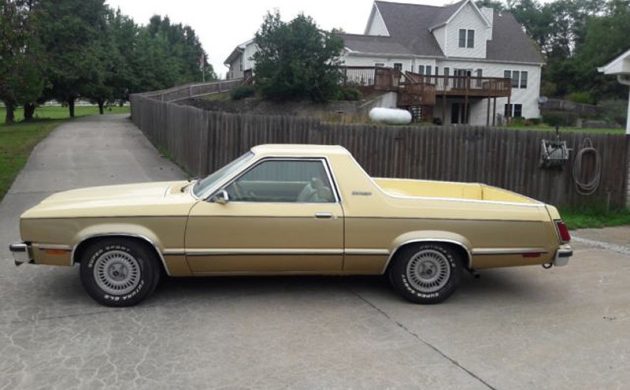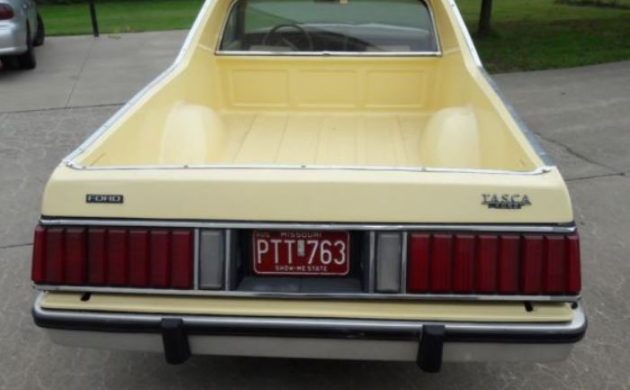Rare Coupe Utility: 1982 Ford Fairmont Durango
What’s a coupe utility? The single differentiator between this vehicle and a pickup is the integration of the front panel of the bed into the rear of the cockpit; pickup beds sit separate from the cabin. The first coupe utility was designed in the early 1930s by Ford Australia, for a customer who wanted a vehicle presentable enough for church on Sundays but capable of hauling pigs on Mondays. The front half of a coupe was grafted onto a pickup bed – and voilà! Once the concept was created, any number of makers sold their own versions, from Studebaker with its Coupe Express to Terraplane. By the late 1950s, the Ranchero and the El Camino infused fins and aero cues into the utility vehicle, inadvertently creating today’s most collectible versions of the genre. Ford quit producing the Ranchero in 1979 but perhaps missing having an entrant in the field (the El Camino was still going strong), the company linked up with National Coach Works to build the Durango. Tony Primo found this rare ute for us – thanks Tony!
The Durango was constructed using the front of a Ford Fairmount two-door coupe and appending a fiberglass bed to its rear. The tailgate, when lowered, leaves the Durango showing no tail lights – buyers were warned not to drive with the ‘gate down. A fiberglass panel between the bed and the ‘gate helps hide the hinges. The first Durangos were sold in 1979; it’s estimated that only 212 were made through 1982, the last year of production.
This one is about as fine an example as a Durango collector could want. Its 94 hp, 200 cu. in. Thriftpower inline six is mated to a three-speed automatic. Power steering and power brakes make for easy control. The seller notes that the odometer reads 41,915 miles and the Durango runs and drives well. The front disc brakes have new pads and calipers; the tires are new.
The interior is in sterling condition but for one small tear in the driver’s seat and a few carpet stains. The door cards are excellent. A factory AM/FM radio is still located in the dash, and it still works. It’s worth mentioning that the seller is a Durango fan – he’s owned several in the last few years and has another that he plans to keep. To find this ’82 Durango, visit David’s Classic Cars here. No price is listed, but a phone number is supplied for questions; the new owner can drive it home from Independence, Missouri. And if this Durango is somehow not spiffy enough, two others are listed on the same site – a low-mileage ’81, and an ’80 with a 306 V8/five-speed Tremac transplant – yeehaw!
Auctions Ending Soon
 2006 Ford Mustang Saleen S281 SCBid Now6 hours$16,000
2006 Ford Mustang Saleen S281 SCBid Now6 hours$16,000
 2002 Subaru Impreza WRXBid Now3 days$333
2002 Subaru Impreza WRXBid Now3 days$333
 1975 Chevrolet Corvette ConvertibleBid Now3 days$3,000
1975 Chevrolet Corvette ConvertibleBid Now3 days$3,000
 1964 Ford F-100 Camper CustomBid Now3 days$2,000
1964 Ford F-100 Camper CustomBid Now3 days$2,000
 2006 Jeep Wrangler SportBid Now5 days$10,500
2006 Jeep Wrangler SportBid Now5 days$10,500





Comments
Gorgeous looking “Ute”, as their called, seeing as we intend them.
When I first looked at the rear, I went OMFG, there’s no tailgate, but fourtently, Michael wrote about the tailgate.
Love it lol 🐎
Why would you ever design something and not take taillights into consideration?
Especially when you see a photo with the tailgate down and realize how easily they could have put redundant taillights in the ends of the quarter panels.
The colonnade El Caminos are designed pretty much the same way. With the tailgate down there is very little ability to see the tail lights in the bumper.
And the license plate!
Hi Michelle, my old Willy utility wagon has a hinged license plate bracket, when the tail gate is down you fold it up so the plate can be seen. When the gate is closed you fold it up and makes a great little table to place a beer bottle !
Aw, cute! Got a photo?
I am not much of a photo guy but I will look Michelle.
My Volvo Amazon (122S) Estate has the folding license plate for driving with the tailgate open. The upper (window) Has different lock positions to vary how much AC I want on the “holder upper”.
This way it’s not bouncing up and down working the gas sturt.
This being a third-party conversion, it would’ve added too much cost to swap to wagon taillights and tool up (or do fiberglass molds for) an entirely new tailgate.
IMO the Fairmont Futura and Mercury Z-7 counterpart were easily the best looking compact coupes of the malaise era. The window line lent itself so well to the utility conversion. Sure, it’s slow and doesn’t haul a lot but that makes it perfect for many people, myself included.
I’ve seen a couple of these in person. Excluding the taillight/tailgate issue, they actually seem like they were fairly well done. Most of the ones I have seen in person and online have the basic straight six/automatic drivetrain with common options (i.e. not loaded). Sales obviously never “took off”, not sure why— the vehicle itself, a declining market segment, manufacturing issues, weak marketing, whatever.
1. Good write-up, Michelle. This is a pretty cool “Cruck”.
2. Seeing that Ford perhaps had the rights to the name “Durango” first (before Dodge / Daimler / Chrysler / Stellantis / Fiat / FCA… or whoever they are now or were then) got me wondering how that all works… trademarking model names and all.
I ran across this which BF readers might find interesting… it sounds like sometimes it’s a “use it or lose it” scenario:
https://www.motor1.com/features/501061/automaker-trademark-name-meaning/
Have a good day!
Chevy used Durango on a trim level of the early S-10
These Durango’s were never marketed properly, that’s for sure. I’ve seen one or two in person, at car shows. But when they were new? I’d never heard of them. Definitely not from Ford. But I wasn’t new car shopping at a dealer, back then. Maybe they had some in store promotions?
Thank you for getting the story right about the origin of the Coupe utility
If Michelle hadn’t, I sure as hell would have.
I wrote this with you in mind, Aussie Dave. I was literally thinking, boy I better get this kinda mostly well maybe perfectly right or Dave will be all over me….
Michelle, I can’t reply to your comment, but yes I’d be all over you…….
I remember the Fairmont as singularly un remarkable at the time. And this version doesn’t change my opinion much!
The ’78 Fairmont was Ford’s most successful vehicle intro since the ’65 Mustang. Good memory.
After the LTD II based Ranchero was discontinued in 1979, Ford dealers wanted something to compete with the El Camino. Ford marketing worked a deal with National Coach to sell the Futura conversions through the Ford dealer network.
They were introduced in 1981 and only sold for two years. Futura’s came off the assembly line without trunk lids or rear seats at were shipped to National Coach in California for conversion. The conversion was done to a high standard as required by Ford. All Durango’s were 3.3L six with automatic transmission. Less than 300 were produced before the fiberglass mold was damaged. Record keeping was poor and the total number produced has never been accurately confirmed. It was reported that the owner of National Coach suffered from health issues and the program never delivered the expected profits. The mold was never repaired and the program was shuttered. Most were titled as Fairmont’s and the Marti Report shows the shipping destination as National Coach, verifying a real Durango. Due the scarcity, some clones have shown up for sale over the years.